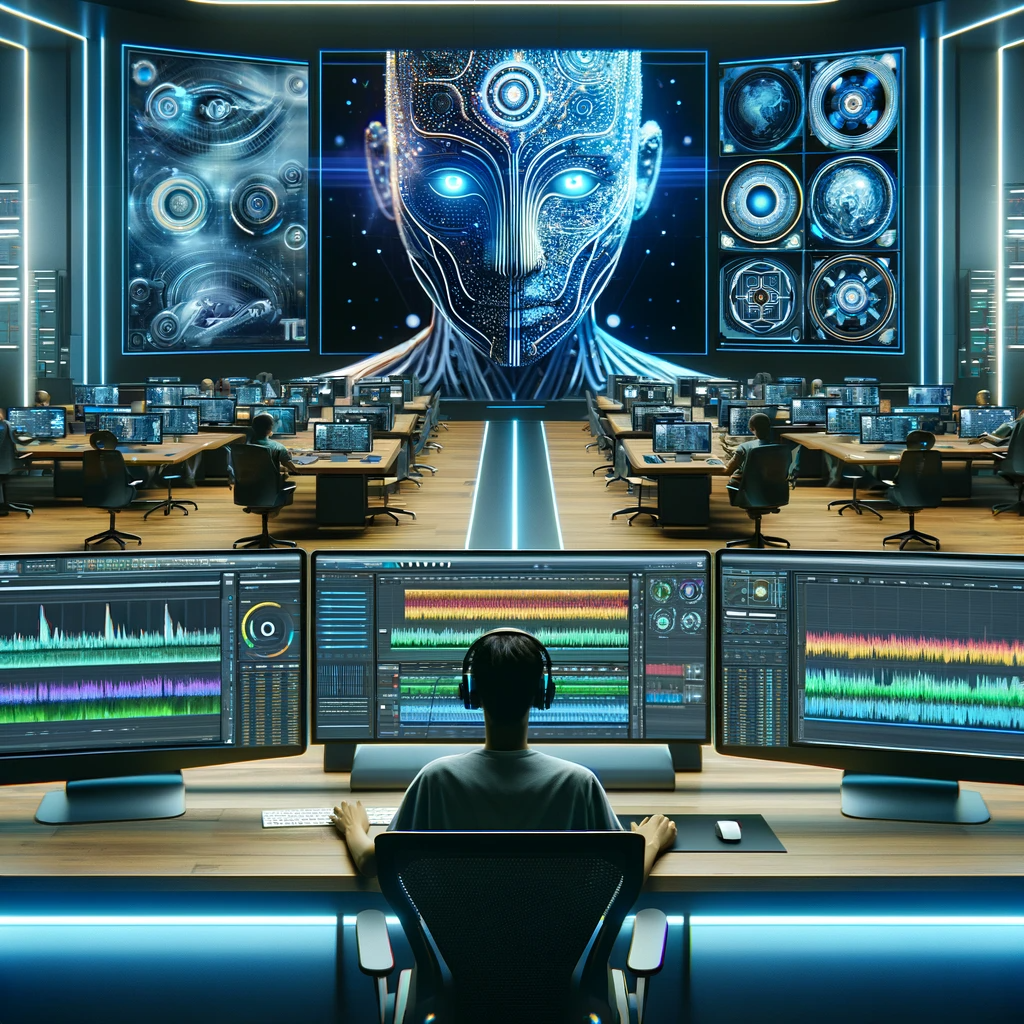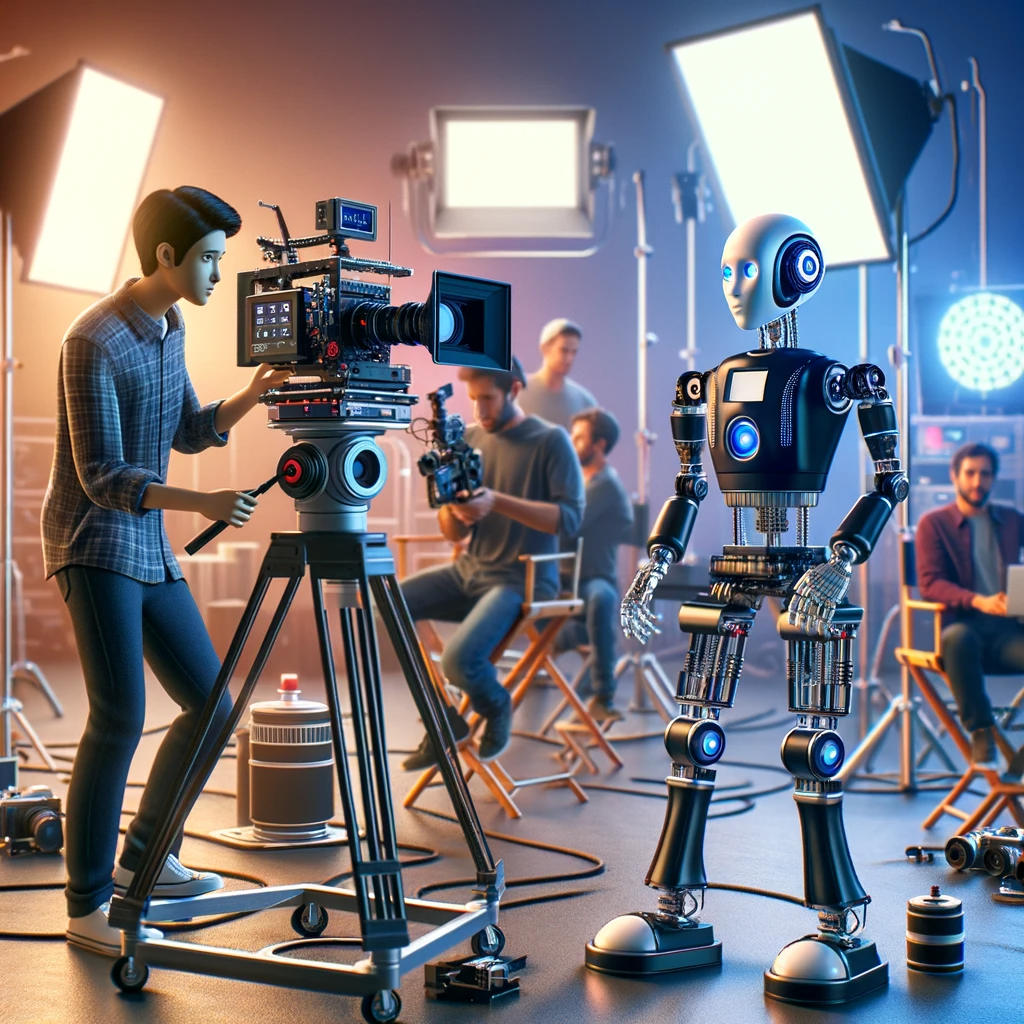The world of filmmaking and video production has always been at the forefront of technological innovation. From the invention of the first motion picture cameras to the digital revolution that brought about high-definition cinematic experiences, the industry has continuously embraced new technologies to push the boundaries of storytelling. In this ever-evolving landscape, Artificial Intelligence (AI) has emerged as a powerful force poised to revolutionize the art of filmmaking.
AI, with its ability to analyze data, learn from patterns, and make informed decisions, has found its place on film sets and editing rooms, impacting every stage of the production process. From script analysis and pre-production planning to post-production editing and marketing strategies, AI is changing the way stories are crafted, told, and shared with audiences worldwide.
This article embarks on a journey to explore the profound impact of AI on the world of filmmaking and video production. We will delve into the various facets of the industry where AI’s presence is felt, examining the tools, techniques, and creative possibilities it brings to the table. From assisting screenwriters in crafting compelling narratives to optimizing lighting and camera work on set, AI is becoming an indispensable partner to filmmakers, enhancing both efficiency and creativity.
Join us as we navigate through the evolving landscape of film and video production, where AI is not just a tool but a catalyst for innovation. In this exploration, we will highlight real-world examples, discuss the challenges and ethical considerations, and envision the limitless possibilities that lie ahead. As we embark on this cinematic journey, we invite you to discover how AI is transforming the art of filmmaking into something both familiar and entirely new.
The Evolution of Filmmaking Technology
The world of filmmaking has witnessed a remarkable evolution in technology over the years. From the Lumière Brothers’ first public screening of moving images in 1895 to the digital age of CGI and 4K resolution, filmmakers have continuously embraced technological advancements to tell captivating stories. The introduction of sound, color, and computer-generated imagery (CGI) revolutionized the way stories were conveyed on the big screen.
This historical context sets the stage for AI’s entry into the world of filmmaking. Just as silent films evolved into talkies and black-and-white scenes transitioned into vibrant colors, AI is now stepping onto the stage to offer new tools and techniques that promise to redefine the filmmaking process.
AI in Script Analysis
One of the earliest stages of filmmaking where AI has made significant inroads is script analysis. AI-driven tools can now analyze scripts for various elements, including content, structure, and emotional tone. For screenwriters and filmmakers, this means having a virtual collaborator capable of providing insights and suggestions for enhancing the narrative.
AI-powered script analysis tools can dissect dialogue patterns, character development, and pacing, offering recommendations to improve storytelling. These tools assist not only in crafting engaging narratives but also in tailoring content to specific target audiences, a valuable asset in today’s diverse and globalized media landscape.
Pre-production and Planning with AI
As filmmakers move into the pre-production phase, AI proves its worth once again. From location scouting and casting to budgeting and planning, AI-driven solutions are streamlining various aspects of pre-production.
AI-powered location scouting tools use vast databases and image recognition to suggest suitable filming locations based on desired criteria. Casting directors benefit from AI algorithms that help identify the ideal actors for specific roles by analyzing factors like facial expressions, acting experience, and previous roles. Budgeting and project planning also benefit from AI’s ability to analyze historical production data and predict resource requirements.
Moreover, AI facilitates the creation of storyboards and shot lists, offering a visual preview of scenes and camera angles. These tools enable filmmakers to plan their shots with precision and efficiency.

Filming and AI-Assisted Production
On the film set itself, AI continues to play a crucial role in optimizing production processes. AI algorithms can analyze real-time scene compositions, lighting conditions, and camera work. They assist directors and cinematographers in making informed decisions on framing, angles, and lighting adjustments.
For instance, AI-driven cameras can automatically adjust focus and exposure based on the movement of actors and objects in a scene. This real-time analysis enhances efficiency during shooting and ensures that every shot meets the desired quality standards.
AI in Post-Production Editing
Post-production is an area where AI’s impact is particularly significant. Video editing, traditionally a labor-intensive process, now benefits from AI-driven automation. AI-powered editing tools can analyze vast amounts of footage, select the best takes, and even assemble scenes based on predefined criteria.
Color grading, a crucial element in setting the visual mood of a film, can also be automated with AI. These tools can analyze reference images or styles and apply them consistently throughout a film. Additionally, AI can enhance special effects and CGI, making it more accessible and cost-effective for filmmakers.
In the next section of this article, we will explore the role of AI in sound and music production, as well as its impact on marketing and distribution strategies in the film industry. The symbiotic relationship between AI and the art of filmmaking continues to evolve, offering new creative possibilities and efficiencies for filmmakers.
Sound and Music with AI
In the world of filmmaking, sound and music are integral components that can profoundly affect the audience’s emotional engagement with a story. AI has found a role in sound editing, design, and music composition, enriching the auditory experience of films.
AI-driven sound editing tools can analyze and enhance audio quality, remove background noise, and adjust volumes seamlessly. This not only saves time during post-production but also ensures that the audio is polished to perfection. In the realm of sound design, AI can generate realistic and immersive soundscapes for scenes, creating a more authentic viewing experience.
One of the most intriguing applications is AI-generated music for film scores. Composers and filmmakers can now collaborate with AI systems that can compose original music in various styles, tailored to the mood and pacing of specific scenes. These AI-composed scores can be customized and adjusted to match the director’s vision, providing a unique blend of human creativity and machine precision.
AI in Marketing and Distribution
The role of AI extends beyond the creative aspects of filmmaking; it also impacts the marketing and distribution strategies that connect films with their audiences. AI’s data analysis capabilities are harnessed to understand audience preferences and optimize marketing campaigns.
AI-driven recommendation systems have become commonplace on streaming platforms. These systems analyze user behavior, viewing history, and preferences to suggest content tailored to individual tastes. Filmmakers and studios leverage AI to identify target audiences, refine advertising strategies, and predict box office performance.
Distribution decisions, such as release dates and geographical markets, are increasingly informed by AI-generated insights. This data-driven approach not only maximizes the potential reach of a film but also ensures that it resonates with its intended audience.
Challenges and Ethical Considerations
While the integration of AI into filmmaking offers numerous advantages, it also presents challenges and ethical considerations. The prospect of job displacement is a concern, as automation in various stages of production may reduce the need for certain roles. Filmmakers must weigh the benefits of efficiency against potential job impacts.
Ethical considerations come into play with the rise of AI-generated content and deepfakes. The ability to create realistic scenes and characters using AI algorithms raises questions about authenticity, copyright, and potential misuse. Filmmakers must tread carefully, ensuring that AI is used responsibly and transparently.
In the next section of this article, we will look ahead to the future possibilities of AI in filmmaking and emphasize the collaborative nature of AI as a tool to enhance human creativity rather than replace it. The cinematic landscape continues to evolve, and AI is a significant part of this transformative journey.
Future Possibilities and Creativity
As we gaze into the future of filmmaking, the possibilities enabled by AI are boundless. AI will continue to evolve and become more sophisticated, offering filmmakers new avenues for creative expression. Rather than replacing human creativity, AI serves as a powerful tool that complements and enhances it.
In the coming years, we can anticipate AI-powered storytelling tools that help screenwriters and directors explore innovative narrative structures. AI-driven virtual actors may become common, enabling filmmakers to bring any character to life with realistic performances. Filmmakers will have access to AI systems that generate breathtaking visual effects and enhance the realism of scenes.
AI’s role in democratizing filmmaking cannot be understated. Smaller, independent filmmakers will have access to AI tools that can level the playing field, allowing them to compete with larger studios in terms of production quality and visual effects.
In conclusion, AI is transforming the art of filmmaking and video production in profound ways, from script analysis to post-production editing and distribution. While challenges and ethical considerations persist, the symbiotic relationship between AI and human creativity is evident. Filmmakers have a powerful ally in AI, one that empowers them to push creative boundaries and tell stories that captivate and inspire audiences worldwide.

Conclusion
In the ever-evolving world of filmmaking and video production, the introduction of Artificial Intelligence (AI) has undeniably marked a significant turning point. This article has explored how AI has seamlessly woven itself into the fabric of filmmaking, from the early stages of script analysis to the final steps of distribution and marketing.
As we conclude this journey through the impact of AI on the art of filmmaking, it becomes evident that the symbiotic relationship between technology and creativity is the driving force behind the industry’s transformation. AI has not only enhanced efficiency and streamlined processes but has also opened doors to new creative possibilities.
From assisting screenwriters in crafting compelling narratives to optimizing lighting and camera work on set, AI has become an indispensable partner to filmmakers. It brings forth both efficiency and creativity, offering a unique blend of human ingenuity and machine precision.
However, it is essential to acknowledge the challenges and ethical considerations that AI brings to the industry. Job displacement, authenticity concerns, and responsible AI use must be addressed carefully as filmmakers embrace this transformative technology.
Looking ahead, the future of filmmaking is teeming with exciting possibilities. AI will continue to evolve, enabling filmmakers to explore innovative narrative structures, create virtual actors, and deliver breathtaking visual effects. Independent filmmakers will have the tools to compete on equal footing with major studios, democratizing the art of filmmaking.
In this ever-evolving cinematic landscape, AI is not merely a tool; it is a catalyst for innovation and a partner in storytelling. Filmmakers, in collaboration with AI, are poised to craft the next generation of cinematic masterpieces that captivate and inspire audiences worldwide.
As we embark on this cinematic journey, we invite you to embrace the transformative potential of AI in filmmaking and envision a future where the boundaries of creativity are expanded, and the art of storytelling is elevated to new heights.
